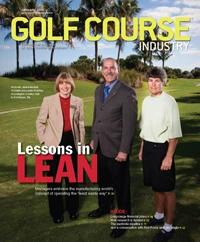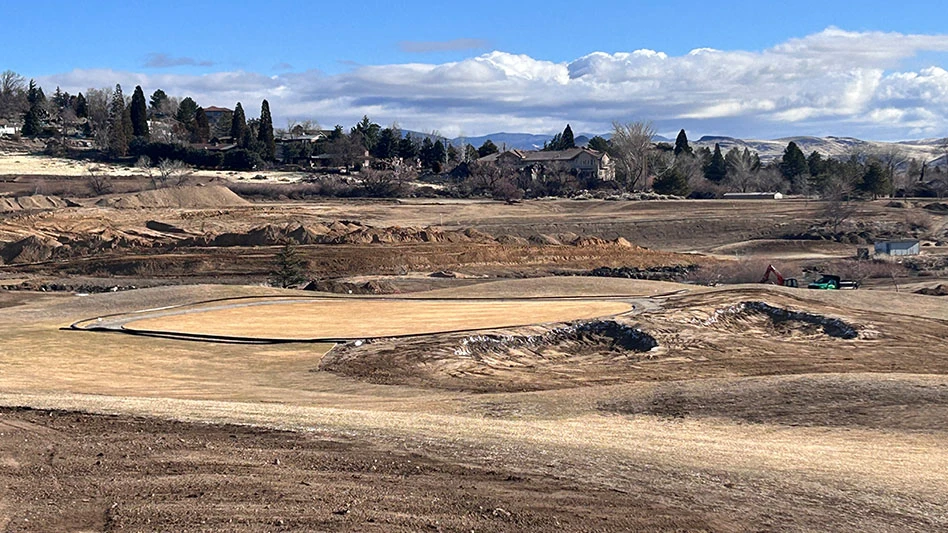After 20 years, more than 140 jobs and an impressive roster of happy clients spread throughout three-quarters of the country, Ron Forse is finally getting some respect as an architect.
Forse and his associate Jim Nagle specialize in remodeling and restoration work – something that never put them in the upper echelon of “name” designers during the heyday of the new construction boom during the 1980s and 1990s. But the reputation they built during that period now serves them quite well because many aging classics need some tender loving care to compete with the new kids on the block. They also specialize in fixing the mistakes of other designers – some competent, some not – who tried to overlay their style or layout philosophies on great courses throughout the years.
They’re almost like the Maytag repairmen of golf … you may not know who they are, but you appreciate the fact they make things work like they were originally supposed to.
Forse is a New Jersey guy by birth but has been at home outside Pittsburgh for years. His path into architecture was laid by an uncle who designed boats, of all things (“I saw that cool drafting table he had, and I was pretty much hooked.”). Like many, he worked on a maintenance crew as a kid and got a taste for the business, but he still ended up earning a degree in landscape architecture from West Virginia University in 1979. He landed in Uniontown, Pa., working for a civil engineer making $10 an hour.
“I’d given up on the idea of being an architect, let alone a golf course designer,” he says. “I was committed to family and faith and didn’t want to travel much. But I finally ventured out into golf design because I couldn’t deny my desires.”
Two decades after making that leap, Forse Designs has become one of a select handful of go-to firms for courses created by golden-age architects such as Donald Ross, A.W. Tillinghast and William S. Flynn. Forse and Nagle do a ton of master-planning and consulting, but playing in the dirt – and reanimating a long-dead architect’s original intent – is their first love. As a result, they’ve completed projects at 11 of Golfweek’s Top 100 classic courses.
Forse and Nagle discuss the current state of the profession, where they see the business going and how fixing the problems created by generations of well-intentioned green committees and amateur architects can be fun and rewarding.
How’s business?
Forse: We’re fortunate because we’ve mostly been in restoration and doing new stuff at old courses, and that trend hasn’t slowed down much. Our goal is to improve the character of what was there already instead of reinventing the design because each course has a genius of place. Clubs seem to appreciate that and seek us out.
How much do you have to market your services?
Forse: We’ve received a number of calls in which ownership is already convinced we’re the right firm. The Broadmoor in Colorado Springs is a good example in which we were already hired before we even knew about it. That’s cool.
On the other hand, we have situations in which it takes a few years, and we have to visit, study and build a relationship. That’s the core of our business – studying the course and the work of other architects, then appropriately applying what we know. Our biggest professional asset is that we’ve become, to some, experts on William Langford, Ross, Tillie, William Flynn and even lesser known guys such as Alex Findlay.
Is the economy cramping your style?
Forse: We’ve slowed down a little, but things are still good. We’re lucky to have great relationships with well-heeled clubs where money is less of an object. Also, we work for clubs that don’t necessarily have a lot of money but have interesting courses with great holes. It’s funny because we’ll go into a meeting with owners, and they somehow think we wouldn’t be interested in them because they’re not rich and famous. We’ll surprise them by sincerely saying, “We think your course is really cool,” in the interview. We don’t mind doing “lesser” name courses if they have great holes or other interesting features.
Which jobs are you most proud of?
Forse: That’s always a difficult question, but Newport, Rolling Green, Philly, Penobscot and Peninsula (in San Mateo, Calif.) Country Clubs come to mind, also Indian Creek in Miami.
I guess our defining project, which isn’t a new course or a true remodel, is Bedford Springs in Pennsylvania. It was a big project – the budget was more than $6 million – and had many facets. It’s a resort that was almost comatose. The hotel was shut down, and the course was just limping along. Spencer Oldham designed it in 1895, then Tillinghast remodeled it, and Ross expanded and remodeled it in 1923. We did a total rebuild in the image of the old styles and feature footprints.
The goal was to achieve a “new-old” look – a retro redo. We leveled out the greens, raised them up and added new bunkers and new mounds while keeping the extant 1895 design. All of it was done in the image of Tillie, Ross and Oldham while making it play well with today’s clubs and balls. It’s a living museum for classic architecture, so we had a special challenge to make it cohesive.
What trends do you see in the design market?
Forse: Ironically, the so-called classic architectural style has become mainstream during the past few years. The modern era – the 1960s and such – is recognized as largely boring, at least until Pete Dye came along. Then there was the pseudo-Scottish look in the 1980s. Then there was the rankings-driven, over-the-top design of the 1980s and 1990s. Now, there’s an increasing appreciation for classic, timeless design. Crenshaw, Coore, Doak and guys like that have given a lot of momentum to naturalized, lay-of-the-land courses. That’s good for us, because people now seem to appreciate what we’ve been doing for 20 years, with new course designs as well. It tends to validate our philosophy that courses from the golden age have a tremendous amount to offer if they’re restored properly.
Nagle: Ron and I will meet with potential clients, and one comment we hear is that we’re adept at preserving the identity and uniqueness of a facility, no matter the budget. We try not to impose our own will on the design. You have to appreciate the golf course for what’s there and make subtle changes rather than redoing it wholesale. We’ve become known for that.
Forse: We like to find what the unique character traits of the course are and then build on them and enhance them. At Preakness Hills, for example, there are these ditches all over the place. They’re meant to be functional, but we put more of them in and pulled them into the design in as part of the theme. It’s cheaper to design based on what’s inspired by the land … and it actually drains.
It seems every architect is now in the redo business. How does that feel?
Forse: In-house or out-of-house, designers who don’t know what they’re doing drive much of our business. Many things that were done to these courses throughout the years don’t function or fit. We’re correcting those mistakes. We love places where they’ve been “frugal” and considerable work hasn’t been done, and we’re just updating bunkers or whatever.
One new trend we see are square tee boxes, which almost have become a cliché and older courses think they have to have them. They don’t have to always be square. They should fit the ground – period. They are functional, but the trend of square tees has almost worn itself out.
Nagle: At Bedford Springs and other places where we’ve done greens reconstruction, the existing green contours are excessive to modern green speeds and, often times, flattening them makes them boring. The challenge is to keep the character and interest and push the outside of the envelope on slopes and what’s cuppable. You’d be surprised at what people will live with in terms of cupping area slopes. You don’t have to have flat putting surfaces just because of speed.
What are good rules for superintendents when working with an architect?
Forse: The only thing that matters is the architect’s ego! But seriously, trust is important. There are some superintendents and pros who get it and trust us as much as we need to trust them. Superintendents usually are good to work with because they’re smart and have common sense. Our position is to work with what they have, not buck the system. However, as part of the team, we also recommend proper changes.
Nagle: Early on, when we’re walking the course with them, we see the same things they do that maybe the members don’t. We understand the opinion of a third-party matters so much to the club. I always try to let them know that when we’re done, we’re done. We have long-standing relationships, but we understand the superintendent has to live with what’s been created. That’s important in terms of materials selection (sand, soil, etc.). They should have input on that stuff. We don’t have a prescription or a set of standards they have to use – it’s never “my way or the highway.”
Forse: It’s important that a superintendent doesn’t let the pressure for absolutely perfect turf conditions override the equally important factors such as interesting bunker and hollow slopes. As designers, we must take a holistic slant and see the big picture, not leaving any aspect of the course behind. Design and maintainability must be balanced.
Nagle: A lot of design work, in the end, seems to be meant to serve less than 5 percent of the membership – the single digit handicappers. We often have to arbitrate and represent the interests of the other 95 percent. We want to stretch tees both directions. You can’t fight the need to move tees back for the great players, but you have to be realistic about the business of golf courses and what sells memberships and rounds to the vast majority of players.
What’s your dream project?
Forse: Bedford Springs was a dream. It was nearby, interesting and fulfilling. We were accountable, but they trusted us. It was gratifying. I relish a bunkerless course project that relies only on the subtleties of the topography and the ground game.
Nagle: I’d love to do a new course where the owner has a deep appreciation for the history of the game from a playability and architecture standpoint, where we could take what we’ve learned from all these old architects and put that into a new design on a good piece of land.
Final thoughts?
Forse: People at these older clubs are starting to appreciate what they have. We work at so many clubs where the members head south for the winter and miss the nuances of those Northern classic courses and how the course plays differently every day. The old Northern (or Southern) classics never get boring. Members never get tired of playing them. They just want them fixed up. It’s like an old sweater. It just feels right when you put it on.

Explore the January 2009 Issue
Check out more from this issue and find your next story to read.
Latest from Golf Course Industry
- The Cabot Collection announces move into course management
- Carolinas GCSA raises nearly $300,000 for research
- Advanced Turf Solutions’ Scott Lund expands role
- South Carolina’s Tidewater Golf Club completes renovation project
- SePRO to host webinar on plant growth regulators
- Turfco introduces riding applicator
- From the publisher’s pen: The golf guilt trip
- Bob Farren lands Carolinas GCSA highest honor







